Medical expert of the article
New publications
Fibropapilloma (fibroma) of the skin
Last reviewed: 07.07.2025

All iLive content is medically reviewed or fact checked to ensure as much factual accuracy as possible.
We have strict sourcing guidelines and only link to reputable media sites, academic research institutions and, whenever possible, medically peer reviewed studies. Note that the numbers in parentheses ([1], [2], etc.) are clickable links to these studies.
If you feel that any of our content is inaccurate, out-of-date, or otherwise questionable, please select it and press Ctrl + Enter.

Fibropapilloma (syn.: fibroma) is a benign tumor, it is a nodular formation of various shapes and sizes, protruding above the skin surface, sometimes on a narrower base. They are usually of a dense elastic consistency, pale pink or brownish in color. They are localized on any part of the skin, but most often on the trunk and head. They exist from birth, but can appear at any age.
Pathogenesis
The basis of the neoplasm is fibrous connective tissue, in which one can often see a significant number of vessels, focal edema, inflammatory infiltrates of varying intensity, and sometimes hyalinosis. The tumor is covered with epidermis of normal structure with unevenly expressed papillary outgrowths, and sometimes with atrophy. There are variants with signs of hyper- and parakeratosis. As a result of secondary inflammatory changes in tumor tissue, sometimes accompanied by ulceration, hemosiderin accumulations and granulation tissue growths are found in the stroma.
The histogenesis of fibropapilloma and papilloma is not fundamentally different. It is just that the epithelial-stromal ratios in these processes are assigned to the side of the epithelial (papilloma) or stromal (fibropapilloma) components.
What do need to examine?
How to examine?
Who to contact?


 [
[